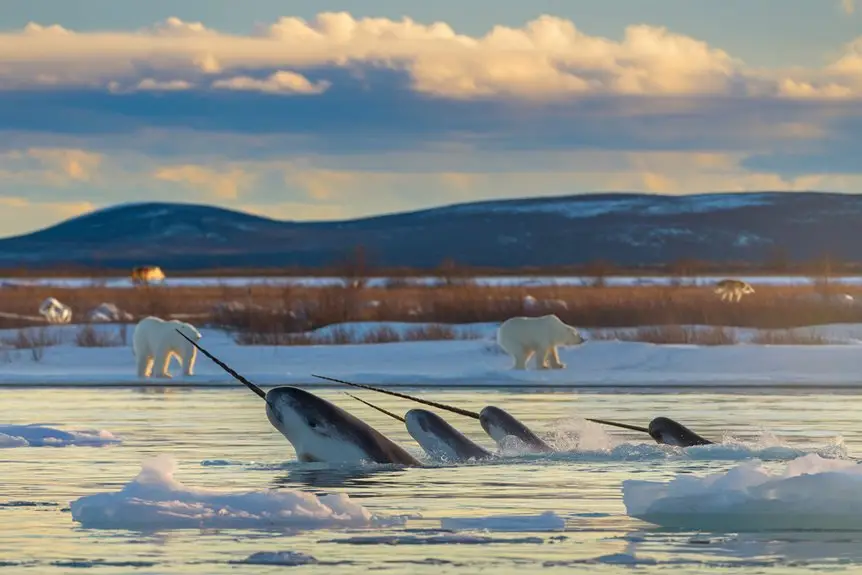Your cruise to Somerset Island takes you to one of Canada’s most exclusive Arctic destinations, welcoming fewer than 1,000 visitors yearly. You’ll reach the island via Bellot Strait, using Zodiac boats to go ashore during the ice-free months of July and August.
For other Canada Cruise destinations check out our Canada Cruise Ship Ports Guide page.
The island offers distinct wildlife viewing opportunities:
- You can watch beluga whales at Cunningham Inlet
- You can spot polar bears near Creswell Bay
- You can visit historical landmarks like Fort Ross trading post and Port Leopold
Essential travel tips:
- You must pack warm clothing layers
- You need to limit your shore excursion baggage to 44 pounds
- You should note the island has no deep-sea ports
Somerset Island rewards you with pristine Arctic wilderness and close wildlife encounters. The untouched landscape and abundant wildlife make this remote location a prime destination for Arctic exploration.
🐧 Polar Cruise Enquiry 🐻❄️
Our team of polar travel specialists have personally explored both the Arctic and Antarctic regions – from tracking polar bears in Svalbard to kayaking with penguins off the Antarctic Peninsula. Let us find the right polar expedition cruise for you.
Getting to Somerset Island
You can reach Somerset Island in two main ways: chartered flights or cruise ships.
For flights:
- Book a 4-5 hour chartered flight from Yellowknife, Northwest Territories
- Arrange private group flights to suit your schedule
- Depart from Yellowknife’s main airport
For cruise ships:
- Your ship will sail through Bellot Strait, a 16-mile channel
- Ships stop at two main points:
- Fort Ross on the southeast coast
- Port Leopold on the northeast tip
- You’ll reach shore in Zodiac boats or inflatable tenders
Important travel notes:
- Nunavut has no deep-sea ports
- Shore transfers are always by small boat
- The island offers Arctic landscapes and historic sites to explore
This remote location needs careful travel planning, but both options give you reliable access to the island.
Best Time to Visit
The best time to visit Somerset Island is during July and August. You can access the island easily during these summer months when the Northwest Passage is free from ice. The temperature rises above freezing, and you get long daylight hours for exploration.
Your wildlife viewing opportunities peak in summer:
- Watch beluga whales at Cunningham Inlet
- Spot polar bears along the coastline
- Take wildlife photos in natural light
You can’t visit from October to April when winter ice blocks ship access.
Summer gives you the safest and most rewarding experience on the island.
Arctic Summer Navigation Months
Planning Your Somerset Island Journey
You can navigate Somerset Island from July through September. The best window starts mid-August and lasts 4-6 weeks.
July offers peak wildlife viewing:
- Flowering plants bloom
- Belugas swim nearby
- Narwhals frequent the waters
Temperature and Conditions:
- Temperatures stay between 5°C and -5°C
- Early season brings extended daylight
- Late season offers Northern Lights viewing
- Ice patterns change weekly
- Weather shifts quickly
Essential Requirements:
- Northwest Passage permits
- Experienced navigation pilots
- Modern charts (available for only 10% of Arctic waters)
Best Times for Specific Activities:
- Wildlife watching: July
- Northern Lights: Late August-September
- Ice-free sailing: Mid-August to early September
You’ll need to monitor weather forecasts and ice reports closely, as conditions determine your exact route and schedule.
Winter Ice Pack Challenges
Winter ice makes Somerset Island‘s waters extremely challenging to navigate between October and June. The sea ice reaches up to 7/10 concentration, making it unsafe for regular vessels.
You need an ice-strengthened ship during winter months. Strong winds above Force 8 create severe icing conditions on vessels. The mix of cold temperatures and freezing spray makes navigation particularly risky.
While thick ice (above 6/10 concentration) reduces spray issues, it limits your ship’s movement.
You should visit between July and September for the safest experience. During these months, the waters become clearer of ice, giving you better access to Somerset Island’s coastline. This period offers you the most reliable navigation conditions.
Key points to remember:
- Visit in summer (July-September)
- Avoid winter unless you have an ice-strengthened vessel
- Watch for freezing spray in strong winds
- Monitor ice concentrations for safe passage
Peak Wildlife Viewing Season
The best time to see wildlife near Somerset Island is July and August. You can watch polar bears move southwest, while marine mammals make the most of summer. At Cunningham Inlet, you’ll find beluga whales swimming with their young calves. Across the tundra, muskoxen compete for territory in impressive displays.
Your second major viewing chance comes in September. Polar bears head back towards Lancaster Sound, and many animals gather where food is plentiful.
The melting ice in August and September creates clear paths through the Northwest Passage. This opens up great viewing spots like Navy Board Inlet and Port Leopold. You’ll see arctic foxes, wolves and lots of seabirds at Prince Leopold Island’s cliffs.
To get the most from your wildlife watching, pick a cruise that can change its route when needed. Make sure it has expert wildlife guides on board.
Shore Excursion Options
Planning your shore excursions lets you explore fascinating historical sites, including the ancient Thule settlement from 1,000 years ago, James Clark Ross’s Port Leopold shelter, and ancient bowhead whale remains dating back 8,000 years.
You’ll get better value and flexibility by booking your tours early, especially if you’re in a group of four or more. Before booking, check the group sizes and travel arrangements for each excursion.
While cost matters, prioritise the quality and suitability of the tour to your interests.
Tips:
- Book excursions well in advance
- Compare group sizes across different tours
- Check transport and timing details
- Consider private tours for larger groups
- Choose based on experience quality, not just price
See what’s on offer from the Baffin Island, Canada for a different Canada Cruise destination.
Wildlife Viewing Opportunities
You can spot incredible Arctic wildlife across Somerset Island throughout your visit.
Polar bears gather near Creswell Bay, where three different groups meet. Muskoxen wander the summer fields, and you might see them charging at each other during mating season.
Cunningham Inlet offers you a special sight – hundreds of beluga whales use it as their nursery area.
The coastline hosts large bird colonies, including up to 5,000 black-legged kittiwakes. You can watch arctic terns as they carry out their long-distance migrations.
Look for peregrine falcons and rough-legged hawks hunting near gull colonies.
You’ll find Pacific and red-throated loons swimming in inland ponds. Arctic wolves and foxes roam freely across the island, giving you excellent chances for wildlife photography.
Historical Landmarks and Sites
Somerset Island offers you a journey through remarkable historical sites. You can visit Fort Ross, an abandoned Hudson’s Bay Company trading post that operated from 1937 to 1948.
The island features Thule-Inuit settlements with preserved whale bones and stone structures from 1000 AD.
You’ll discover Fury Beach, where sailors left HMS Fury’s supplies in 1825.
Port Leopold holds significance as James Clark Ross’s winter shelter in 1848.
The Idlout family settlement at Creswell Bay, inhabited until 1991, shows recent human presence.
The island connects to Sir John Franklin’s expedition through sites at nearby Beechey Island.
You can examine archaeological findings that reveal centuries of human activity, including an 800-year-old whale skeleton that tells the story of early settlements.
Travel Tips and Requirements
Getting to Somerset Island
You need to take a chartered flight from Yellowknife, as the island is only reachable by air or specialised cruise ships. Your baggage limit is 44 pounds per person, so pack light with essential layered clothing for Arctic weather.
Travel Requirements:
- Travel insurance (mandatory)
- Weather-appropriate clothing
- Safety gear for activities
Your Accommodation Options:
- Cruise ships offer:
- Expert lectures
- Observation decks
- Full amenities
- Arctic Watch wilderness lodge provides:
- Guided adventures
- Local expertise
- Comfortable rooms
Your Essential Activities Gear:
- ATV riding equipment
- Kayaking gear
- Safety equipment
Your Safety Guidelines:
- Follow guide instructions
- Stick to marked routes
- Maintain group contact
Plan your trip well in advance due to the island’s remote location.
Pack according to your planned activities and always prioritise safety gear.
Frequently Asked Questions
What Emergency Medical Facilities Are Available on Somerset Island?
Somerset Island has no medical facilities. You must rely on air evacuation for any medical emergencies. The closest emergency healthcare services are in Nunavut communities, with Iqaluit being the main medical centre you can access. Make sure you have proper emergency evacuation coverage when visiting the island.
Can Passengers Use Drones to Photograph Wildlife During Shore Excursions?
You cannot use drones to photograph wildlife during shore excursions on Somerset Island. The Arctic ecosystem is sensitive, and local regulations protect the animals from aerial disturbance. Your regular camera is the best choice for capturing wildlife photos whilst respecting both the environment and local rules.
Is Satellite Phone or Internet Service Available While Visiting Somerset Island?
Mobile connectivity on Somerset Island is limited. You can access basic satellite Wi-Fi at Arctic Watch Lodge. Satellite phones exist on-site but are restricted to emergency use only.
Are There Age Restrictions for Zodiac Excursions Around Somerset Island?
While Somerset Island Zodiac trips don’t have strict age limits, your ability to join depends on your physical fitness. You need to:
- Board the Zodiac safely
- Hold on throughout the journey
- Follow safety instructions clearly
- Move steadily in varying weather conditions
Your overall fitness and mobility matter more than your age. Just check with your tour operator about specific requirements before booking.
What Currency Is Accepted at Fort Ross and Arctic Watch Lodge?
Canadian dollars are the main currency at Fort Ross and Arctic Watch Lodge. You should bring Canadian dollars for your visit. While some services might accept US dollars, exchange your money before travelling. These remote locations don’t have banks or currency exchange facilities nearby. You’ll find it easier to pay for everything with Canadian dollars during your stay.
Thinking about something different? Check out the cruises leaving from Prince Leopold Island, Canada.
🐧 Polar Cruise Enquiry 🐻❄️
Our team of polar travel specialists have personally explored both the Arctic and Antarctic regions – from tracking polar bears in Svalbard to kayaking with penguins off the Antarctic Peninsula. Let us find the right polar expedition cruise for you.














